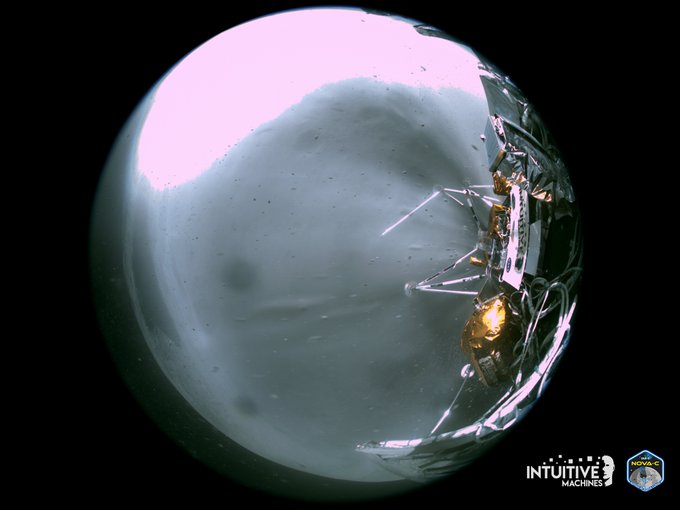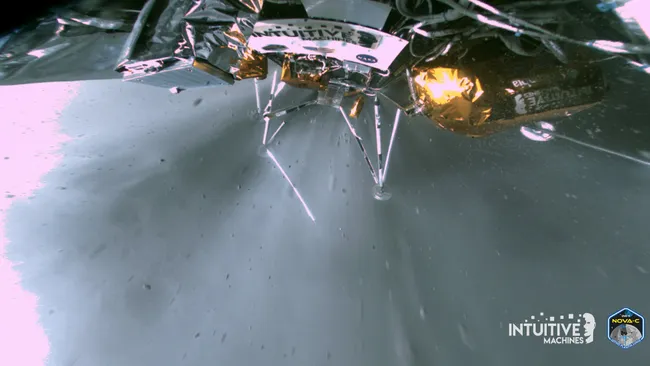Intuitive Machines’ daring lunar mission, the first American moon landing since Apollo 17 in 1972, took a dramatic turn last week when its valiant lander, Odysseus, suffered a setback during its historic touchdown. Despite the broken leg, the mission team is celebrating a successful data transmission and remains optimistic about the future of the mission.
Odysseus, a 14-foot-tall robotic explorer, touched down on the lunar south pole on Thursday, February 22nd. The landing, however, wasn’t quite textbook. An unexpected glitch in its navigation system caused the six-legged lander to descend faster than planned and settle on terrain slightly higher than intended.
“It was a bumpy ride,” admitted Steve Altemus, CEO and co-founder of Intuitive Machines, during a press briefing today. “The landing gear bore the brunt of the impact, and we ended up with a fractured leg, possibly two.”
Related: SpaceX Pauses Intuitive Machines’ Moon Mission: What Does the Launch Delay Mean?
The unexpected tilt, caused by the uneven terrain and the broken leg, presented a challenge. Odysseus landed at a 30-degree angle, preventing it from using its high-gain antenna for optimal communication with Earth and casting a shadow over its main solar array.
However, the resourceful mission team wasn’t about to give up. They skillfully utilized Odysseus’ low-gain antenna to transmit valuable data and imagery back to Earth, including a photo that clearly captured the damage to the landing leg.
“Though not ideal, the image demonstrates the remarkable ability of Odysseus’ landing struts to absorb the impact, protecting the mission’s integrity,” Intuitive Machines stated in a recent post. “The image also shows the engine still throttling, which likely provided crucial stability during the landing.”
Another image, a “selfie” captured by Odysseus itself just yesterday, offered a glimpse into the lander’s current state. While the initial attempts to transmit photos from landing and the following days were unsuccessful, this latest transmission provided valuable insights into the lander’s position on the lunar surface.

“We’re thrilled to finally receive clear visuals,” said Altemus. “These images will be instrumental in planning our next steps.”
One of the mission’s most anticipated elements, the EagleCam deployment, also encountered obstacles. This student-built camera system, designed to capture the final phase of the descent from the lunar surface, was originally planned for deployment at an altitude of 100 feet. However, due to the navigation issues, the mission team opted to keep it onboard.
Fortunately, EagleCam was finally deployed today and currently sits around 13 feet from Odysseus. While the team is still troubleshooting some technical issues with the camera, they remain hopeful for future success.
ALSO READ: Ancient Galaxy Defies Logic, Upending Cosmology: Webb Telescope Reveals Early Universe ‘Monster’
EagleCam is just one of the 12 payloads carried by Odysseus, which launched atop a SpaceX Falcon 9 rocket on February 15th. Six of these payloads are scientific experiments or technology demonstrations sponsored by NASA’s Commercial Lunar Payload Services (CLPS) program.
“We’re ecstatic to have received data from all five of the operational CLPS instruments,” shared Sue Lederer, CLPS project scientist at NASA’s Johnson Space Center. “The remaining payload is a passive laser reflector designed to assist other spacecraft navigation.”
The data transmission comes just as Intuitive Machines prepares to power down Odysseus for the upcoming lunar night, which can last roughly two weeks. The frigid lunar temperatures pose a significant threat to the lander’s electronics and batteries, potentially leading to its demise.

“Despite the challenges, Odysseus has consistently surprised us with its resilience,” remarked Lederer. “We’ve overcome numerous obstacles, and this little lander has proven to be quite the fighter. I have full faith in Odie, as we affectionately call it.”
With the mission at a critical juncture, the team awaits the lunar sunrise with cautious optimism, determined to extract as much scientific data as possible from their tenacious little lander, Odysseus. The future may hold uncertainties, but one thing is certain: the spirit of exploration and the ingenuity of the human mind continue to shine brightly, even on the distant lunar surface.
